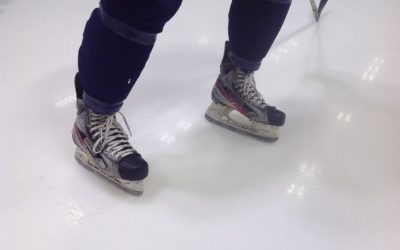Making a stop, a question of observation
We know that a goalkeeper’s speed of response is not just a reflex, but a conscious process of information processing (reaction time). But what does a goalkeeper really react to? How does he determine the puck’s trajectory so quickly?
You’d think the goalie would react to the shot only after the puck has been hit. If this were the case, the guard’s response time would have to be so short as to be well beyond these physiological limits. For example, for a shooter positioned 10 m from the goalkeeper and shooting at 140 km/h, the goalkeeper would have 0.257s to determine the puck’s trajectory and execute the motion to make the save. Even for the fastest goalkeepers on the planet, this is impossible.
Goalkeepers therefore use other visual information to estimate the puck’s trajectory even before it is struck (4). In some studies, researchers have hidden goalkeepers’ eyes a fraction of a second before puck contact to see what their reaction would be (1,3). Not only did the goalkeepers make the right move to stop the puck, but their reaction time was just as good as when they had access to visual information at all times (1).
The main visual cues used by goalkeepers are the position of the player’s hips, the movement of his shoulders, the trajectory and orientation of the stick, and the position of the supporting leg (6,7). Although most visual cues are components of the player’s movement, the goalkeeper’s gaze is very often on the puck as it is shot (2). In fact, a beginner keeper will tend to wait longer before reacting than an expert keeper (5). Beginners are therefore less able to anticipate the puck’s trajectory and need more information on its movement.
In short, the goalkeeper uses elements of the shooter’s movement to predict the puck’s trajectory and make the save. Improving a goalkeeper’s skills therefore involves developing their ability to recognize different movement patterns in players. This raises the question of whether goalkeepers who train with shooters without equipment benefit fully from their training, since the elements of recognition are not the same given the size of field hockey players’ equipment.
Written by Léandre Gagné Lemieux, M.Sc. Kinesiology
References
1- Baker J, Farrow D, Elliot B, Anderson J (2009) The influence of processing time on expert anticipation. Int J Sport Psychol 40:476-488
2- Bard, C., & Fleury, M. (1981). Considering eye movement as a predictor of attainment. In I. M. Cockerill & W. M.
3- MacGillvary (Eds.), Vision and sport (pp. 28-41). Cheltenham, England: Stanley Thornes (Publishers) Ltd.
4- Farrow D, Abernethy B, Jackson RC (2005) Probing expert anticipation with the temporal occlusion paradigm: Experimental investigations of some methodological issues. Motor Control 9:330-349.
5- Panchuk D, Vickers JN (2006) Gaze behaviors of goaltenders under spatial-temporal constraints. Hum Mov Sci 25 :733-752.
6- Samela JH, Fiorito P (1979) Visual cues in ice hockey goaltending. Can J Appl Sci 4(1):56-59.
7- Savelsbergh, G. J. P., Williams, A. M., Van der Kamp, J., & Ward, P. (2005). Anticipation and visual search behaviour in expert soccer goalkeepers. Ergonomics, 48, 1686-1697.
Want to stay on top of new articles before they’re published?
Subscribe to our newsletter.
From the same author
Why is it easier to turn left?
Why is it easier to turn left? MAXIME Sports physiotherapist In a field hockey match, various skating techniques are used to counter the opponent. A technique of choice for quickly changing direction while maintaining good speed is the sharp turn. On the one hand,...

